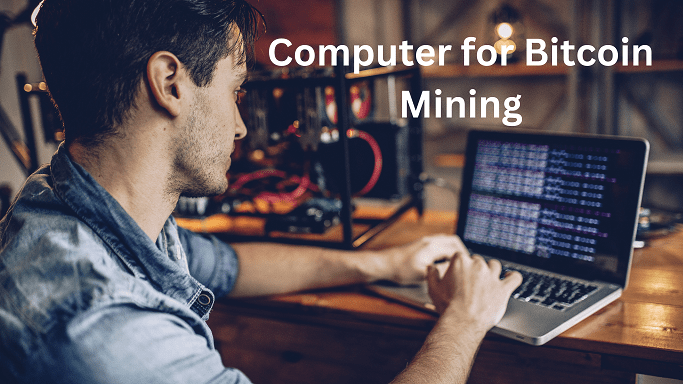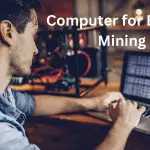Cryptocurrency has taken the world by storm, with Bitcoin being the most well-known form. Bitcoin mining is the process of earning Bitcoin by using a computer to solve complex mathematical problems. Here is a guide on how to generate cryptocurrency from your computer.
Definition of Bitcoin Mining
Bitcoin mining is the process of earning Bitcoin by using computer hardware to perform complex calculations. When a miner solves a block, they earn Bitcoin as a reward.
Purpose of Bitcoin Mining
Bitcoin mining primarily aims to validate transactions and add them to the blockchain. Miners earn rewards for doing so.
Why Bitcoin Mining is Profitable
As the world becomes more digital, Bitcoin and other cryptocurrencies are gaining value. As the value increases, mining becomes more profitable.
Understanding the Basics of Bitcoin Mining
How Bitcoin Works
Bitcoin is a decentralized digital currency that uses encryption techniques to secure transactions and to verify the transfer of funds. Every transaction is recorded in a public ledger called the blockchain.
How Transactions Are Processed
When someone sends Bitcoin, the transaction is sent to the blockchain and verified by miners. Once the transaction is confirmed, it is recorded on the blockchain.
Decentralization of Bitcoin
Bitcoin is decentralized, which means that there is no single authority that controls it. This allows for transactions to be completed without needing a central authority, such as a bank or government.
Bitcoin Mining Hardware Requirements
What is Needed for Bitcoin Mining
To mine Bitcoin, you will need a computer with a powerful processor and a lot of memory. You will also need a Bitcoin wallet to store your earnings.
Types of Bitcoin Mining Hardware
There are two main types of Bitcoin mining hardware: ASICs and GPUs. ASICs are more powerful, but GPUs are more affordable.
Choosing the Right Software for Bitcoin Mining
Types of Bitcoin Mining Software
There are three types of Bitcoin mining software: desktop, mobile, and web-based.
Features of Bitcoin Mining Software
Different Bitcoin mining software has different features, such as support for different mining pools, ease of use, and customizability.
Factors to Consider in Choosing Bitcoin Mining Software
When choosing Bitcoin mining software, factors include cost, ease of use, support for different mining pools, and compatibility with your hardware.
Setting Up Your Bitcoin Mining Rig
Assembling Your Bitcoin Mining Rig
Assembling your Bitcoin mining rig involves assembling the necessary hardware, including your computer, power supply, and cooling system.
Configuring Your Bitcoin Mining Rig
Once your Bitcoin mining rig is assembled, you must configure it. This involves downloading and installing the necessary software.
Joining a Bitcoin Mining Pool
What is a Bitcoin Mining Pool
A Bitcoin mining pool is a group of miners who work together to solve blocks and earn rewards.
Advantages of Joining a Bitcoin Mining Pool
Joining a Bitcoin mining pool can increase your chance of earning Bitcoin rewards.
Choosing the Right Bitcoin Mining Pool
When choosing a Bitcoin mining pool, factors include size, fees, and the pool’s reputation.
Operating Your Bitcoin Mining Rig
Monitoring the Performance of Your Bitcoin Mining Rig
To operate your Bitcoin mining rig, you must monitor its performance and adjust as needed.
Addressing Common Issues and Troubleshooting Your Bitcoin Mining Rig
Common issues with Bitcoin mining rigs include overheating and hardware failure. Troubleshooting these issues involves pinpointing the cause and making necessary repairs.
Optimizing Your Bitcoin Mining Strategy
To maximize your Bitcoin mining earnings, you must optimize your mining strategy. This involves finding the right balance between risk and reward.
Scaling Up Your Bitcoin Mining Operation
You can increase your Bitcoin mining earnings by adding more mining rigs to scale up your operation.
Keeping Your Bitcoin Mining Safe and Secure
Protecting Your Bitcoin Wallet
To keep your Bitcoin earnings safe, you must protect your wallet by using strong passwords and regularly backing up your data.
Avoiding Bitcoin Mining Scams
There are many Bitcoin mining scams out there. To avoid them, you should be wary of offers that seem too good to be true.
Safeguarding Your Bitcoin Mining Investment
To safeguard your Bitcoin mining investment, you must monitor your earnings and keep your hardware and software up to date.

The Future of Bitcoin Mining
Evolution of Bitcoin Mining Technology
Bitcoin mining technology constantly evolves, introducing new hardware and software regularly.
Latest Trends in Bitcoin Mining
Recent trends in Bitcoin mining include using renewable energy sources and developing new mining algorithms.
Quick Look into Altcoin Mining
Altcoin mining involves mining other cryptocurrencies aside from Bitcoin. Altcoins can offer different benefits, such as faster transaction speeds and lower fees.
Conclusion
Bitcoin mining can be a profitable way to earn cryptocurrency. First, you must choose the proper hardware and software, join a mining pool, optimize your strategy, and keep your earnings safe.
Frequently Asked Questions
How much money can be made from Bitcoin Mining?
The amount of money you can make from Bitcoin mining depends on various factors, including the cost of electricity and the price of Bitcoin.
What is the best hardware and software for Bitcoin Mining?

The best hardware for Bitcoin mining depends on your budget and mining goals. ASICs are more powerful, but GPUs are more affordable.
Bitcoin mining requires significant computational power, so a good computer configuration for mining would typically include the following:
Graphics Processing Unit (GPU): Choose a high-performance GPU specifically designed for mining, such as NVIDIA or AMD. Look for models with high hash rates and energy efficiency.
Central Processing Unit (CPU): While the CPU is less critical for mining Bitcoin than the GPU, it can still play a role in overall mining performance. Opt for a powerful CPU to support mining operations.
Memory (RAM): Aim for a sufficient amount of RAM, typically 8 GB or more, to ensure smooth mining operations and efficient data processing.
Power Supply Unit (PSU): Select a reliable power supply with sufficient wattage to handle the power demands of your mining hardware. Consider energy efficiency to optimize mining profitability.
Motherboard: Choose a motherboard that supports multiple GPUs and has enough PCIe slots for expansion.
Storage: A solid-state drive (SSD) or a hard disk drive (HDD) with enough storage capacity is sufficient for mining operations.
Cooling: Mining generates significant heat, so ensure adequate cooling with fans, heat sinks, or even liquid cooling systems to maintain optimal temperatures and prevent hardware damage.
Internet Connection: A stable and high-speed internet connection is essential for efficient mining and maintaining connectivity to the mining pool or network.
Mining Software: Install reliable mining software that is compatible with your hardware. Popular options include CGMiner, BFGMiner, and EasyMiner.
What is Cloud Mining?
Cloud mining involves renting computational power from a remote data center to mine Bitcoin.
Can Bitcoin Mining Harm My Computer?
Bitcoin mining can strain your computer’s hardware, but it is generally safe if done correctly.


